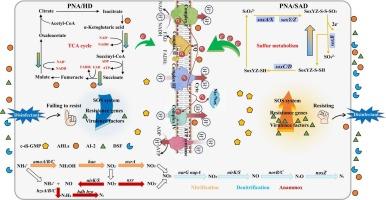在不同的部分硝化-厌氧氨氧化耦合反硝化系统中,消毒剂诱导不同的代谢机制:能量转化和微生物应激反应
IF 11.3
1区 环境科学与生态学
Q1 ENGINEERING, ENVIRONMENTAL
引用次数: 0
摘要
优化部分硝化厌氧氨氧化(PNA)系统的脱氮效率并研究其在消毒剂胁迫下的性能是污水深度处理的关键。本研究比较了PNA/异养反硝化(PNA/HD)和PNA/硫自养反硝化(PNA/SAD)系统在消毒剂胁迫下的分化机制。两种系统最初都实现了高效的脱氮;然而,在高消毒剂水平下,随着厌氧氨氧化活性的下降,PNA/SAD系统的总无机氮去除率保持在93.97%,显著优于PNA/HD系统的75.46%。PNA/SAD增加了细胞外聚合物(EPS)的产生,而PNA/HD则降低了EPS的水平,且抗氧化活性不足。PNA/SAD中氨氧化基因的丰度是PNA/HD的4.03-4.28倍,好氧条件下napA的上调证实了SAD在含消毒剂环境中的优势。编码三羧酸循环关键脱氢酶的基因下调导致PNA/HD的能量供应不足。相比之下,PNA/SAD维持稳定的硫氧化,提供连续的电子供应。PNA/SAD群体感应协同调节生物膜稳定性、抗性基因(RGs)和毒力因子的表达,确保生物膜的长期稳定性。相反,PNA/HD由于RGs和毒力因子的下调而丧失了环境适应性。本研究突出了PNA/SAD的多方面抗逆性机制,为消毒剂胁迫下的工艺优化提供了理论依据。本文章由计算机程序翻译,如有差异,请以英文原文为准。

Disinfectants induce divergent metabolism mechanisms in different partial nitrification-anammox coupled denitrification systems: Energy transformation and microbial stress response
Optimizing nitrogen removal efficiency in partial nitrification anammox (PNA) system and elucidating its performance under disinfectants stress are crucial for advanced wastewater treatment. This study compared PNA/heterotrophic denitrification (PNA/HD) and PNA/sulfur autotrophic denitrification systems (PNA/SAD) to reveal their divergence mechanisms under disinfectants stress. Both systems achieved efficient nitrogen removal initially; however, under high disinfectant levels, with anammox activity declining in both systems, PNA/SAD maintained a total inorganic nitrogen removal efficiency of 93.97 %, significantly outperforming PNA/HD at 75.46 %. PNA/SAD enhanced extracellular polymeric substance (EPS) production, while PNA/HD exhibited lower EPS levels and insufficient antioxidant activity. The abundance of ammonia oxidation genes in PNA/SAD was 4.03–4.28 times higher than that in PNA/HD, with up-regulation of napA under aerobic condition confirming SAD’s advantage in disinfectant-containing environments. Down-regulation of genes encoding key dehydrogenases in the tricarboxylic acid cycle led to an insufficient energy supply in PNA/HD. In contrast, PNA/SAD maintained stable sulfur oxidation, providing a continuous electron supply. Quorum sensing in PNA/SAD synergistically regulated biofilm stability, resistance genes (RGs) and virulence factors expression, ensuring long-term stability. Conversely, PNA/HD lost environmental adaptability due to the down-regulation of RGs and virulence factors. This study highlighted the multifaceted stress resistance mechanisms of PNA/SAD, providing a theoretical basis for process optimization under disinfectants stress.
求助全文
通过发布文献求助,成功后即可免费获取论文全文。
去求助
来源期刊

Journal of Hazardous Materials
工程技术-工程:环境
CiteScore
25.40
自引率
5.90%
发文量
3059
审稿时长
58 days
期刊介绍:
The Journal of Hazardous Materials serves as a global platform for promoting cutting-edge research in the field of Environmental Science and Engineering. Our publication features a wide range of articles, including full-length research papers, review articles, and perspectives, with the aim of enhancing our understanding of the dangers and risks associated with various materials concerning public health and the environment. It is important to note that the term "environmental contaminants" refers specifically to substances that pose hazardous effects through contamination, while excluding those that do not have such impacts on the environment or human health. Moreover, we emphasize the distinction between wastes and hazardous materials in order to provide further clarity on the scope of the journal. We have a keen interest in exploring specific compounds and microbial agents that have adverse effects on the environment.
 求助内容:
求助内容: 应助结果提醒方式:
应助结果提醒方式:


